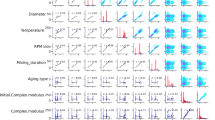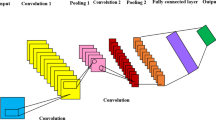Abstract
The compressive strength is most reliable parameter to evaluate the ability of concrete in resisting compression. The paper presents a study on prediction of the compressive strength of roller compacted concrete using multiple regression analysis (MRA) and artificial neural networks (ANN). The compressive strength of roller compacted concrete was obtained experimentally at 3, 7 and 28 days of curing. The samples were prepared by varying the percentage of cement and superplasticizer. The data were organized in three different groups randomly using R statistical software. The models were executed with cement content, coarse and fine aggregate, superplasticizer content, water content and days of aging as input parameters that were used to predict compressive strength which is the output parameter. The analysis was performed using multiple regression and artificial neural networks methodology. Statistical measures like root-mean-square error (RMSE), mean absolute error (MAE) and coefficient of determination are used to assess the performance of models. The determination coefficient from multiple regression analysis is found to be 0.975 and 0.886 for testing and validating the data correspondingly, whereas the determination coefficient from artificial neural network analysis is found to be 0.9 for both testing and validating the data. The results obtained from ANN are highly accurate because of its own topology.








Similar content being viewed by others
References
ASTM A 370–03, Standard Test Methods and Definitions for Mechanical Testing of Steel Products, West Conshohocken, Pennsylvania: American Society for Testing and Materials (2004).
Bilgehan M (2011) A comparative study for the concrete compressive strength estimation using neural network and neuro-fuzzy modelling approaches. Nondestructive Testing and Evaluation 26(01):35–55
Boukhatem B, Ghrici M, Kenai S, Tagnit-Hamou A (2011) Prediction of efficiency factor of ground-granulated blast-furnace slag of concrete using artificial neural network. ACI Mater J 108(1):55
Chithra S, Kumar SS, Chinnaraju K, Ashmita FA (2016) A comparative study on the compressive strength prediction models for High Performance Concrete containing nano silica and copper slag using regression analysis and Artificial Neural Networks. Constr Build Mater 114:528–535
Correia SL, Partala T, Loch FC, Segadães AM (2010) Factorial design used to model the compressive strength of mortars containing recycled rubber. Compos Struct 92(9):2047–2051
Dantas ATA, Leite MB, de Jesus Nagahama K (2013) Prediction of compressive strength of concrete containing construction and demolition waste using artificial neural networks. Constr Build Mater 38:717–722
Debbarma S, Ransinchung RNGD, Singh S (2019) Feasibility of roller compacted concrete pavement containing different fractions of reclaimed asphalt pavement. Constr Build Mater 199:508–525. https://doi.org/10.1016/j.conbuildmat.2018.12.047
Deshpande N, Londhe S, Kulkarni S (2014) Modeling compressive strength of recycled aggregate concrete by Artificial Neural Network, Model Tree and Non-linear Regression. Int J Sustain Built Environ 3(2):187–198
Faraj RH, Mohammed AA, Mohammed A, Omer KM, & Ahmed HU (2021) Systematic multiscale models to predict the compressive strength of self-compacting concretes modified with nanosilica at different curing ages. Engineering with Computers, 1–24.
Fu Z, Mo J, Chen L, Chen W (2010) Using genetic algorithm-back propagation neural network prediction and finite-element model simulation to optimize the process of multiple-step incremental air-bending forming of sheet metal. Mater Des 31(1):267–277
Hesami S, Modarres A, Soltaninejad M, Madani H (2016) Mechanical properties of roller compacted concrete pavement containing coal waste and limestone powder as partial replacements of cement. Constr Build Mater 111:625–636. https://doi.org/10.1016/j.conbuildmat.2016.02.116
IS 8112–1989. Specification for OPC-43 grade cement. Bureau of Indian Standard, New Delhi.
IS: 383–2016, Specification for coarse and fine aggregate from natural sources for concrete.
Ministry of Roads Transport and Highways (MoRTH) 2013, Specifications for Road and Bridges works, Fifth Revision, Indian Road Congress, New Delhi.
Nuruddin MF, Ullah Khan S, Shafiq N, Ayub T (2015) Strength prediction models for PVA fiber-reinforced high-strength concrete. J Mater Civ Eng 27(12):04015034
Palika Chopra RK, Sharma, Maneek Kumar (2014) Regression models for the prediction of compressive strength of concrete with and without fly ash, Int. J. Latest Trends Eng. Tech. 3 (4) 400–406.
Sadrmomtazi J, Sobhani MA (2013) Mirgozar, Modeling compressive strength of EPS lightweight concrete using regression, neural network and ANFIS. Constr Build Mater 42:205–216. https://doi.org/10.1016/j.conbuildmat.2013.01.016
Salimbahrami SR, Shakeri R (2021) Experimental investigation and comparative machine-learning prediction of compressive strength of recycled aggregate concrete. Soft Comput 25(2):919–932
Satyanarayana PVV, Pradeep N, Nandini N (2013) "A Study on the Performance of Crusher Dust In Place Of Sand and Red Soil as A Subgrade And Fill Material" IOSR Journal of Mechanical and Civil Engineering (IOSR-JMCE) e-ISSN: 2278–1684,p-ISSN: 2320–334X, Volume 9, Issue 2, PP 53–57.
Siddique R, Aggarwal P, Aggarwal Y (2011) Prediction of compressive strength of self-compacting concrete containing bottom ash using artificial neural networks. Adv Eng Softw 42(10):780–786
Tavakoli D, Fakharian P, de Brito J (2021) Mechanical properties of roller-compacted concrete pavement containing recycled brick aggregates and silica fume. Road Materials and Pavement Design. https://doi.org/10.1080/14680629.2021.1924236
Tsivilis G (1995) Parissaki, A mathematical model for the prediction of cement strength. Cement Concrete Res 25(1):9–14. https://doi.org/10.1016/0008-8846(94)00106-9
Tsivilis S, Batis G, Chaniotakis E, Grigoriadis G, Theodossis D (2000) Properties and behavior of limestone cement concrete and mortar. Cem Concr Res 30(10):1679–1683
Yeh I-C (1999) Design of high – performance concrete mixture using neural networks and nonlinear programming. J Comput Civil Eng 13(1):36–42
Yuan Z, Wang L-N, Ji X (2014) Prediction of concrete compressive strength:research on hybrid models genetic based algorithms and ANFIS. Adv Eng Softw 67:156–163. https://doi.org/10.1016/j.advengsoft.2013.09.004
Zain MFM, Abd SM (2009) Multiple regression model for compressive strength prediction of high-performance concrete. J Appl Sci 9(1):155–160
Author information
Authors and Affiliations
Corresponding author
Ethics declarations
Conflict of interest
The authors declare that they have no known competing financial interests or personal relationships that could have appeared to influence the work reported in this paper.
Rights and permissions
About this article
Cite this article
Abhilash, P.T., Satyanarayana, P.V.V. & Tharani, K. Prediction of compressive strength of roller compacted concrete using regression analysis and artificial neural networks. Innov. Infrastruct. Solut. 6, 218 (2021). https://doi.org/10.1007/s41062-021-00590-1
Received:
Accepted:
Published:
DOI: https://doi.org/10.1007/s41062-021-00590-1




